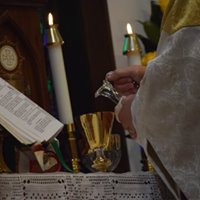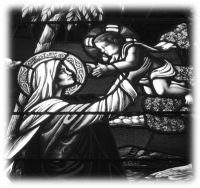Musical Notes
![]()
MUSIC NOTES
MUSIC NOTES
The Second Sunday of Advent is also known as Bible Sunday. This is due to the Collect from 1549 and the Epistle that reflects the interest for acquainting people with the contents and teachings of the Bible during the Reformation period.
Prelude Veni Emmanuel Gerald Kemner/Alec Wyton
The Advent hymn text (Hymn #2) “O Come, O Come Emmanuel” is based on the Great O Antiphons that have been part of the Advent liturgy since the 9th century. It was united with the familiar chant by John Mason Neale in 1851 when he translated the latin text into English. The congregational refrain is sung in Latin prior to the Processional Hymn (after verse 3 is sung by a choir member). The setting by Gerald Kemner (1932-2007), composition professor at the University of Missouri/Kansas City, uses the chant with an accompaniment of “slow unfolding strands of harmony punctuated by markedly contrasting rich harmonies.” Alec Wyton (1921-2007), New York’s Cathedral of St. John the Divine organist-director, uses the tune in fragmented form and in imitation.
Introit Populus Sion.
(Isaiah 30:19a) O People of Sion, (Isaiah 30:27a) behold the Lord is nigh at hand to redeem the nations: (Isaiah 30:29b) and in the gladness of your heart (Isaiah 30:30a) the Lord shall cause his glorious voice to be heard.(Psalm 80:1a) Hear, O thou Shepherd of Israel: thou that leadest Joseph like a sheep.
Gradual
(Psalm 50:2, 5) Out of Sion hath God appeared: in perfect beauty. Gather my saints together unto me: those that have made a covenant with me with sacrifice.
Alleluia, alleluia. (Luke 21:26b-27) For the powers of heaven shall be shaken. And then shall they see the Son of man coming in a cloud with power and great glory. Alleluia.
Offertory
(Psalm 85:6, 7) Wilt not thou turn again, O God, and quicken us, that thy people may rejoice in thee? Shew us thy mercy, O Lord, and grant us thy salvation.
Anthem Zion Hears the Watchmen Singing J. S. Bach
Johann Sebastian Bach (1685-1750) wrote his cantata (#140) in 1731 during his time as musician at St. Thomas Church in Leipzig, Germany. He used the hymn “Wachet auf” (Wake, Awake) in three of its seven movements. The anthem (movement 4), a setting of verse two of this Advent hymn (#3 in The Hymnal 1940), places the tune phrases intermittently against a rhythmic melodic accompaniment
Communion
(Baruch 5:5a) Jerusalem, haste thee, and stand on high:
(Baruch 4:36b) and behold the joy and gladness that cometh unto thee from God thy Saviour.
The Recessional Hymn (#5) text is by the 18th century Anglican priest and a founder of the Methodist movement, Charles Wesley (author of over 6500 hymn texts). Published in 1758, the poem is expresses the human reaction to the 2nd coming of Christ, known as the 2nd Advent. The tune Helmsley was first published in a collection of Wesley hymns in 1765.
Postlude Creator alme siderum J. S. Bach
The Advent chant “Creator of the stars of night” (Hymn #6) is the basis for Bach’s short chorale prelude (from the “Little Organ Book”) with the tune in long notes in the soprano.





